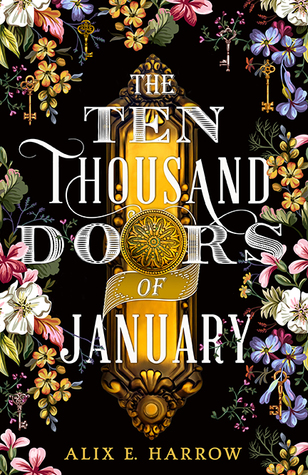- The Good: Book-within-a-book about doors that lead to other worlds
- The Bad: Some pacing and motivation issues
- The Literary: Beautiful elaborate prose
Early in the 20th century, deep within the sprawling Vermont mansion of Mr. Locke and his collection of rare artifacts, January Scaller waits for the fleeting moments when her father returns from his travels and brings another item to Mr. Locke’s collection. With her mother presumed dead, Mr. Locke raises January to be quiet and dutiful, though she still receives raised eyebrows from high society women for her cedarwood-colored skin. On her seventeenth birthday, she finds a strange book about secret doors that lead to other worlds and a young woman named Adelaid who finds some doors of her own.
There’s so much to love about The Ten Thousand Doors of January. First, it’s a love letter to books and the places they can take you. It’s a book about escapism and adventure, but the open doors also represent an open mind and a willingness to accept people, culture, and a world totally unlike your own. The plot structure of a book-within-a-book works really well here. The turn-of-the-century aristocratic setting brings a historical backdrop that feels appropriate for Mr. Locke’s cabinet of curiosities and children left to fend for themselves in an old manor house. The prose is rich and warm and lyrical; best read in low light with a blanket. Really, the prose is beautiful.
I also enjoy the themes of family and separation, especially that a happy ending isn’t necessarily an ending that forgives all wrongs. I like January’s near-constant companion, her dog Sinbad, a very good boy nicknamed Bad, but he’s figuratively kicked so many times I was in danger of putting down the book in fear that he wouldn’t make it. January sees herself as an in-between girl, unable to fit in the world in which she lives. On the surface, her dark skin gives her away. But underneath, she wants to explore like her father instead of being cooped up in an old musty house while wearing pretty dresses.
Although this is not a fault in the book, I do want to make it clear this isn’t exactly a portal fantasy, even though it’s described as such. Technically, January does travel through doors to other worlds, but those worlds aren’t the centerpiece of the novel, or at least aren’t full of fantastical creatures. Most of the worlds January spends time in are more like foreign countries than Narnia. I was hoping for more world-building.
January dreams of exploring, but she’s really not sure where or how. And once her adventure begins, the plot similarly meanders and doesn’t move along without help from nearby adults instead of January’s own tenacity. Actually, January does something incredible on her own about halfway through the book, but then she falls back into the hands of capable adults and the forward-momentum and stakes fall, even when traveling to other worlds and being pursued by enemies.
Highly recommended for fans of quietly magical books, lyrical prose, and love stories about family!
